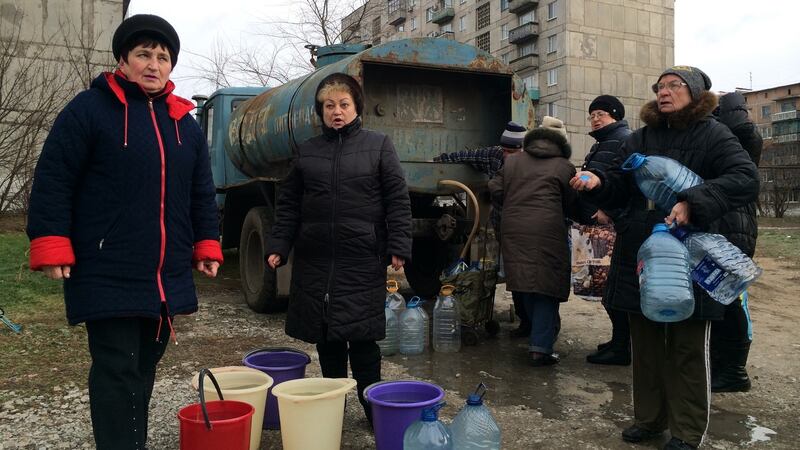Like its meandering rivers – the Aidar, Kalmius, Siverskyi Donets and others – the man-made waterways of eastern Ukraine make no allowances for its war.
As they criss-cross the front line between government forces and Russian-backed separatists, they are often ensnared by a conflict that since spring 2014 has divided the Donbas region and its 4.5 million people.
For more than a week there has been no running water in the town of Toretsk, where 70,000 people eke out a living among dilapidated tower blocks and three ailing coal mines, while nearby artillery booms almost every night.


"On November 22nd a shell hit a big water pipe and cut us off," says Serhii Vinnik, deputy head of the town council.
The mayor of Toretsk, Volodymyr Sleptsov, was arrested in August over alleged links to separatists who briefly controlled the town in 2014; now they are about 20km away, and their "capital" of Donetsk is just 50km to the south.
The main Siverskyi Donets-Donbas canal runs close to Toretsk, but the town receives its water supply from a filtering station in separatist-held territory, and fighting has halted the flow on several occasions.
On Tuesday, a complete ceasefire was agreed around Toretsk to allow a mine removal team to make the area safe for workers to fix the damaged pipe, which lies in a buffer zone between government and separatist positions.
“We pray that the repair team stays safe,” says Vinnik. “If everything goes well, we could have water by the weekend.”
Until then, tankers will continue to deliver hundreds of thousands of litres of water for residents and for Toretsk’s Soviet-era central heating system, which came under strain as people drained their radiators for water to flush toilets, clean their apartments and other basic needs.
“It’s a nightmare,” says Valya Burakova (66), as she fills armfuls of plastic bottles from an old blue tanker parked in a muddy courtyard.
“These trucks don’t stick to their timetable, we have to carry so many bottles and buckets, and look at this water – it looks too murky to drink.”
“It’s not easy, son,” says her friend since schooldays, Alexander Babenko (66).
“I do hope the water is back on by the weekend – and that we live that long. But at least the heating in our building works, and it’s not too cold yet.”
Falling temperatures
It is getting colder, though. Snow fell across the region on Tuesday night and the temperature was forecast to dip to minus 10 on Wednesday.
Many schools in Toretsk were closed at the end of last week due to the water shortage and heating problems, but School Number 13 stayed open.
“We have our own water tanks and make sure they are always filled,” said Valentina Trifonova, director of a school that sits about a kilometre from the buffer zone.
“We’ve had our problems, though. Shelling destroyed half the roof and blew out our windows. Thankfully it was during the summer holidays so the children weren’t here,” she says, pointing to shrapnel scars along the front wall of the school.
The repairs were paid for by Unicef, the United Nations children's fund, which has helped fix and improve facilities in dozens of schools in the region.
As hopes rise for the return of running water to Toretsk, however, in another front line area the International Committee of the Red Cross is warning of a potential “humanitarian disaster”.
The group says that 600,000 people living on both sides of the front in Luhansk region could lose their water supply, if an electricity firm cuts power to local water companies that fail to pay their bills by a December 1st deadline.
In October the Red Cross covered $700,000 (€650,000) of the firms’ debts to keep water flowing, on the proviso that they reach a long-term deal by the end of November.
Ukrainian officials say the separatists are charging people for water but refusing to pay the electricity supplier, while blaming the “fascist” Kiev government for the looming crisis.
"If the power is turned off and the water stops flowing, there will be a major impact on households, schools, hospitals and infrastructure," says Sanela Bajrambasic, a spokeswoman for the Red Cross in Ukraine.
“In these cold temperatures the pipes could freeze and break, and then repair work would be needed as well in the middle of winter. This could cause a humanitarian disaster.”
Soviet engineers
Most of the region’s water comes from the Siverskyi Donets-Donbas canal, which was built by Soviet engineers in the 1950s, and pipelines linked to it.
The system snakes in and out of the conflict zone, feeding strategic government-held towns like Sloviansk and Mariupol, and supplying the main separatist-controlled city of Donetsk along the way.
"We still work with our old colleagues on the other side to keep the system working," says Sergei Suprun, head of the Semenivka section of the canal near government-held Sloviansk.
Two of his colleagues – mother and son Galina and Maksim Semichev – were killed when shells hit the pumping station in June 2014 and caused major damage that the United Nations Development Programme helped repair with financing from Japan.
“We are proud of what we do,” says Suprun, who has worked here for 34 of his 58 years. His nearby flat was also wrecked by artillery fire.
“Millions of ordinary citizens rely on the water we pump. What we do is not politics – it’s about getting water to them.”











